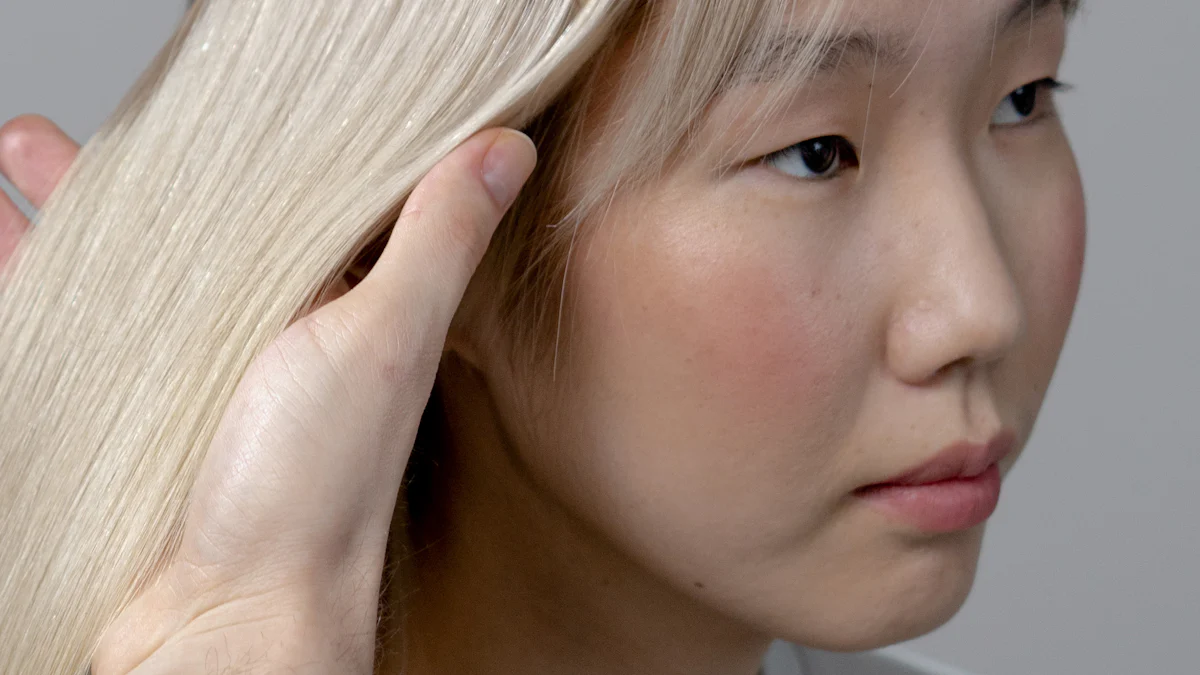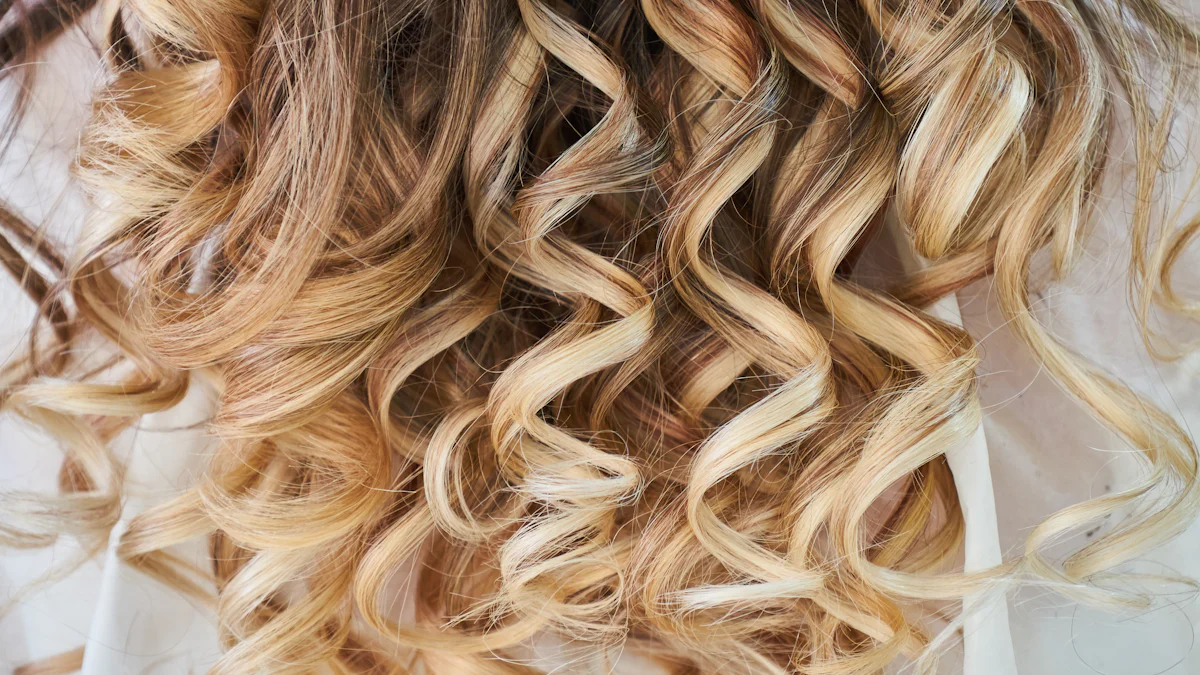How to Flawlessly Install a Lace Front Wig

Lace front wigs offer a versatile option for achieving natural-looking hairstyles. These wigs have gained popularity worldwide due to their realistic appearance and comfort. Lace front wigs provide the perfect balance between a natural look and durability. The two main installation methods include glue and glueless options. Each method offers unique benefits. Whether you prefer a secure hold or frequent changes, lace front wigs can meet your needs. Discover how to make a wig a lace front flawlessly and enjoy the versatility and beauty of this hair solution. Join the Luvmeforyou community and embrace the elegance of lace front wigs today!
Understanding Lace Front Wigs
What is a Lace Front Wig?
A Lace Front Wig features a lace strip at the front of the wig cap. This lace strip creates a natural-looking hairline. The lace blends seamlessly with your skin. You can part the hair in different ways. The lace front design offers versatility and realism.
Features of Lace Front Wigs
Lace Front Wigs offer several key features:
Natural Hairline: The lace front mimics a natural hairline.
Versatility: You can style the hair in various ways.
Comfort: The lace material feels lightweight and breathable.
Durability: High-quality lace ensures long-lasting wear.
Benefits of Using Lace Front Wigs
Using Lace Front Wigs provides many benefits:
Realistic Appearance: The lace front makes the wig look like natural hair.
Styling Options: You can experiment with different hairstyles.
Confidence Boost: A natural look enhances your confidence.
Ease of Use: The wigs are easy to put on and take off.
Types of Lace Front Wigs
Lace Front Wigs come in various types to suit different needs and preferences.
Synthetic vs. Human Hair
Synthetic Hair Wigs:
Affordable: Synthetic wigs cost less than human hair wigs.
Low Maintenance: These wigs require minimal care.
Pre-Styled: Synthetic wigs come in pre-set styles.
Human Hair Wigs:
Natural Look: Human hair wigs look and feel like real hair.
Versatility: You can style these wigs with heat tools.
Longevity: Human hair wigs last longer with proper care.
Pre-Plucked vs. Customizable Hairlines
Pre-Plucked Hairlines:
Ready to Wear: Pre-plucked wigs save you time.
Natural Look: These wigs have a realistic hairline.
Customizable Hairlines:
Personalized Fit: You can customize the hairline to suit your face.
Flexibility: Customizable wigs offer more styling options.
Preparation
Preparing Your Natural Hair
Washing and Conditioning
Start with clean hair. Use a gentle shampoo to wash away any dirt or product buildup. Follow up with a conditioner to keep your hair soft and manageable. Rinse thoroughly to remove all product residue. Clean hair ensures a better grip for the wig.
Braiding or Flattening Hair
Next, flatten your hair. Braiding works well for this step. Create small, tight braids to keep your hair flat against your scalp. You can also slick back your hair using gel or mousse. The goal is to have a smooth surface for the wig cap.
Preparing the Wig
Customizing the Hairline
Customize the hairline for a natural look. Use tweezers to pluck some hairs from the front. This step mimics a natural hairline. Be careful not to over-pluck. A few strands at a time will do the trick. Customizing the hairline enhances the overall appearance of the wig.
Tinting the Lace
Tint the lace to match your skin tone. Use a lace tint spray or foundation. Apply the product evenly across the lace front. This step helps the lace blend seamlessly with your skin. Properly tinted lace makes the wig look more realistic.
Installation Methods

Glue Method
Tools and Products Needed
To apply a lace front wig using glue, gather the following tools:
Wig Cap: A nylon cap to flatten your natural hair.
Wig Glue: Choose a strong adhesive like
Got2B Glued Spray.Rattail Comb: For precise parting and smoothing.
Alcohol Prep Pads: Clean your skin for better adhesion.
Nail Cutting Scissors: Trim the lace accurately.
White Eyeliner: Mark the placement of the wig.
Blow Dryer: Use the cool setting to set the glue.
Step-by-Step Guide
Prepare Your Natural Hair: Wash, condition, and braid or slick back your hair. Wear a wig cap to keep your hair flat.
Clean Your Hairline: Use alcohol prep pads to remove oils and dirt from your skin.
Mark the Placement: Use white eyeliner to outline where the lace front will sit.
Apply the Glue: Apply a thin layer of wig glue along your hairline. Let it become tacky.
Position the Wig: Align the lace front with the marked line. Press the lace into the glue.
Secure with a Blow Dryer: Use the cool setting to set the glue. Press the lace with the back of a comb for a seamless blend.
Trim the Lace: Use nail cutting scissors to trim excess lace. Follow the natural curve of your hairline.
Final Touches: Style the wig as desired. Use foundation on the lace for a natural look.
Glueless Method
Tools and Products Needed
For a glueless wig installation, you will need:
Wig Cap: A nylon cap to secure your natural hair.
Wig Grip: A band to hold the wig in place.
Rattail Comb: For parting and smoothing.
Styling Mousse: To style baby hairs and edges.
Silk or Satin Scarf: To set the wig in place.
Step-by-Step Guide
Prepare Your Natural Hair: Wash, condition, and braid or slick back your hair. Wear a wig cap to keep your hair flat.
Wear a Wig Grip: Place the wig grip around your head. Ensure it sits comfortably and securely.
Position the Wig: Place the lace front wig on your head. Adjust the combs and elastic straps for a snug fit.
Secure with Clips: Use the built-in clips to anchor the wig. Position the clips at the sides and back.
Style Baby Hairs: Apply styling mousse to create baby hairs. Use a rattail comb for precision.
Set with a Scarf: Wrap a silk or satin scarf around your head. Leave it on for 10-15 minutes to set the wig.
Final Touches: Remove the scarf and style the wig as desired. Use foundation on the lace for a natural look.
Tips for Perfect Installation
Choosing the Right Lace Color
Choosing the right lace color can make or break your wig installation. The lace should blend seamlessly with your skin tone. Swiss lace and French lace are popular options. Swiss lace is thinner and more delicate, offering a natural look. However, it is prone to tearing. French lace is thicker and more durable, making it ideal for beginners. To find the perfect match, hold the lace against your skin. Compare different shades under natural light. This step ensures the lace front looks invisible.
Cutting the Lace Correctly
Cutting the lace correctly is crucial for a flawless finish. Start by putting the wig on your head. Align it with your natural hairline. Use white eyeliner to mark where you want the lace to lay. Take the wig off and place it on a flat surface. Use nail cutting scissors for precision. Cut small sections at a time. Follow the natural curve of your hairline. Avoid cutting too much lace at once. This method prevents mistakes and ensures a snug fit.
Creating Baby Hairs
Creating baby hairs adds realism to your lace front wig. Start by sectioning off a small amount of hair at the front. Use a rattail comb for precise parting. Trim the hair to a shorter length. Apply styling mousse to the baby hairs. Use the comb to shape them into soft curls or waves. Wrap a silk or satin scarf around your head. Leave it on for 10-15 minutes to set the style. Baby hairs enhance the natural look of your wig.
Using Foundation for a Natural Look
Achieving a natural look with your lace front wig involves using foundation. Start by selecting a foundation that matches your skin tone. This step ensures the lace blends seamlessly with your scalp. Place the wig on your head and align it with your natural hairline. Use an adjustable strap if available to keep the wig secure.
Next, take a makeup brush or sponge and apply the foundation directly onto the lace. Focus on the areas around the hairline and parting. This technique helps the lace disappear against your skin. Dab the foundation gently to avoid smudging. Ensure even coverage for a flawless finish.
For added realism, use a translucent setting powder. Lightly dust the powder over the foundation. This step sets the makeup and prevents it from rubbing off. The powder also reduces shine, making the lace look more like your natural scalp.
After applying the foundation, style your wig as desired. Use a rattail comb to create a parting. Adjust the baby hairs for a more natural appearance. Wrap a silk or satin scarf around your head for 10-15 minutes. This step helps set the foundation and baby hairs in place.
Using foundation transforms the look of your lace front wig. The lace blends perfectly with your skin, creating a seamless and natural appearance. This simple trick boosts your confidence and enhances the overall look of your wig.
Maintenance and Styling

Maintaining and styling your lace front wig ensures longevity and keeps it looking fabulous. Follow these tips for daily care and styling to keep your wig in top condition.
Daily Care Tips
Brushing and Detangling
Brushing and detangling your wig daily prevents knots and tangles. Use a wide-tooth comb or a wig brush designed for synthetic or human hair wigs. Start from the ends and work your way up to the roots. This method minimizes breakage and maintains the integrity of the lace front. Avoid brushing when the wig is wet to prevent damage. For curly wigs, use your fingers or a wide-tooth comb to maintain the curl pattern.
Storing the Wig
Proper storage extends the life of your lace front wig. Store your wig on a wig stand or mannequin head to retain its shape. Keep the wig away from direct sunlight and heat sources. Cover the wig with a silk or satin scarf to protect it from dust. If you travel, store the wig in a breathable bag to prevent tangling.
Styling Tips
Heat Styling
Heat styling allows you to change your wig's look. Use heat tools like flat irons or curling wands on human hair wigs. Set the tools to a low or medium temperature to avoid damaging the hair. Always apply a heat protectant spray before styling. For synthetic wigs, use heat-friendly products specifically designed for synthetic fibers. Avoid excessive heat to maintain the quality of the lace front.
Using Hair Products
Using the right hair products enhances the appearance of your wig. Choose products formulated for wigs to avoid buildup and damage. Use a lightweight leave-in conditioner to keep the hair soft and manageable. Apply a small amount of serum or oil to add shine and reduce frizz. Avoid heavy products that can weigh down the hair and affect the lace front's natural look. Style the wig with mousse or gel to create baby hairs and define curls or waves.
Choose the method that suits your preferences. Overcome common challenges in wig application with patience and practice. Achieve a flawless install by following these steps. Enjoy the versatility and beauty of lace front wigs. Embrace the confidence that comes with a perfect look.






















